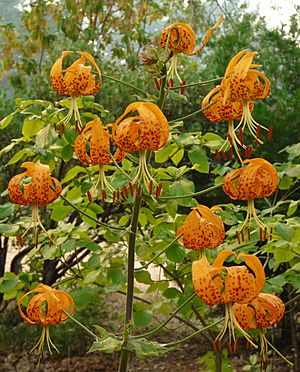Humboldt's lily facts for kids
Quick facts for kids Humboldt's lily |
|
|---|---|
 |
|
| Scientific classification | |
| Kingdom: | |
| (unranked): | |
| (unranked): | |
| Order: | |
| Family: | |
| Genus: | |
| Species: |
L. humboldtii
|
| Binomial name | |
| Lilium humboldtii Roezl & Leichtlin, 1871
|
|
| Synonyms | |
|
Synonymy
Lilium canadense var. puberulum Torr., Pacif. Railr. Rep. Parke, Bot. 4(5; 4): 146 (1857).
Lilium puberulum (Torr.) Duch., J. Soc. Natl. Hort. Paris, sér. 2, 4: 217 (1870). Lilium canadense var. humboldtii Baker, Gard. Chron. 1871: 1165 (1871). Lilium bloomerianum Kellogg, Proc. Calif. Acad. Sci. 4: 160 (1872). Lilium robinsonianum Baker, J. Linn. Soc., Bot. 14: 244 (1874). Lilium humboldtii var. bloomerianum (Kellogg) Jeps. 1921, illegitimate name Lilium humboldtii var. bloomerianum Purdy< 1901, illegitimate name (syn of L.h. subsp. ocellatum) Lilium bloomerianum var. ocellatum Kellogg (syn of L.h. subsp. ocellatum) Lilium humboldtii var. ocellatum (Kellogg) Elwes (syn of L.h. subsp. ocellatum) Lilium ocellatum (Kellogg) Beane (syn of L.h. subsp. ocellatum) Lilium bloomerianum Purdy illegitimate name (syn of L.h. subsp. ocellatum) Lilium humboldtii var. bloomerianum Purdy (syn of L.h. subsp. ocellatum) Lilium humboldtii var. magnificum Purdy (syn of L.h. subsp. ocellatum) Lilium fairchildii M.E.Jones (syn of L.h. subsp. ocellatum) |
|
Lilium humboldtii, also called Humboldt's lily, is a type of lily flower. It grows naturally in California in the United States and Baja California in Mexico. This plant was named after Alexander von Humboldt, a famous explorer and naturalist.
You can find Humboldt's lily in mountain areas like the South High Cascade Range and the Sierra Nevada. It grows at heights from about 600 meters (2,000 feet) to 1,200 meters (4,000 feet) above sea level.
Contents
What Humboldt's Lily Looks Like
Humboldt's lily can grow quite tall, sometimes up to 1.8 meters (6 feet) high. Its flowers are usually golden-orange with dark red or maroon spots. The parts inside the flower, called stamens, are orange to brown.
The plant blooms in June. Its flowers grow in a shape that looks like a pyramid. The stems that hold the flowers are strong and sometimes have a brown-purple color.
The bulb of the plant, which is underground, is very large. It has yellowish-white scales and grows deep in the soil. The leaves of the lily grow in circles around the stem. They are shiny and have a wavy edge. After it flowers in mid to late summer, the plant rests and dies back until the next growing season.
Subspecies of Humboldt's Lily
There are two main types, or subspecies, of Humboldt's lily:
- Lilium humboldtii subsp. humboldtii - This type is found in central California.
- Lilium humboldtii subsp. ocellatum - This type grows in southern California and Baja California.
Both of these subspecies are listed by the California Native Plant Society. They are considered "fairly endangered" in California, meaning they are a bit rare and need protection.
A scientist named Albert Kellogg once gave this plant a different name, Lilium bloomerianum. He didn't know that other scientists had already named it. For a while, people used his name for the southern California subspecies.
Growing Humboldt's Lily in Gardens
Humboldt's lily can be bought and grown in gardens. It likes to have a dry summer rest period, meaning it doesn't need much water after it finishes blooming. It also needs soil that drains water well, so its roots don't sit in soggy ground. It prefers some shade rather than full sun.
This lily is also special because it was used to create new types of lilies. It was crossed with another lily, Lilium pardalinum, to make the Bellingham hybrid lilies. These hybrids then led to popular garden lilies like 'Shuksan' and 'Star of Oregon'.
See also
 In Spanish: Humboldt's lily para niños
In Spanish: Humboldt's lily para niños

